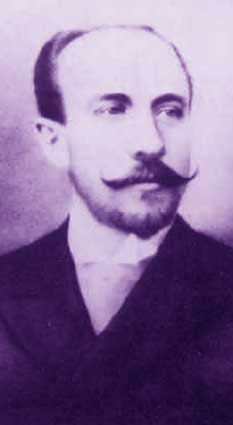Melies Part I:
Demons in the Films of Georges Melies
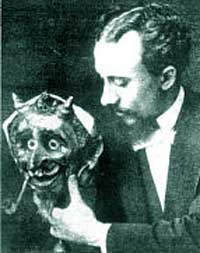 Demons, imps, or the Lord of Darkness Himself were recurring characters & even stars in the films of Georges Melies. Though approaching dark subjects, he had a light-hearted view of diabolism.
Demons, imps, or the Lord of Darkness Himself were recurring characters & even stars in the films of Georges Melies. Though approaching dark subjects, he had a light-hearted view of diabolism.
His earliest films were two or three minute jests with magical incidents, though occasionally he would achieve something "epic" exceeding ten minutes length. Given the brevity of the films it's surprising how complete & rich many of them are.
Melies was clearly a genius at many aspects of filmmaking, but his genius as a short-short storyteller is sometimes forgotten amidst the cleverness & invention of his pioneering work in special FX. Really, as a master of the short-short fiction vignette, his brilliance cannot be overestimated.
It's possible that if he took his own art more seriously he wouldn't've gone down paths of Satanic comedy. He regarded himself lightly & seemed to have no egoistic sentiment nor merely self-aware realization of the importance of his work. There were on the order of 500 films in his library when the French Army took most of his films to melt them down & recycle them as the heels of boots for soldiers of the first world war.
Still other of his films were wiped clean, re-chemicalized, & new films made on the same stock, while others simply caught fire in the primitive projection equipment, or were otherwise lost to attrition during circulation to the earliest exhibitors. For these reasons a great many of Melies films simply do not survive. But copies had been dispersed widely in Europe & North America, & we have enough of them today that a veritable study could be made of his films, & frequently has been made.
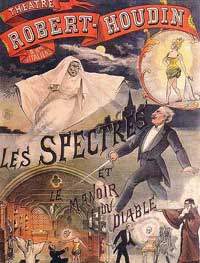 The Devil's Manor (Le Manoir du diable, 1896) has gone by several English titles, known also as The Haunted Castle, The Devil's Castle, or The House of the Devil.
The Devil's Manor (Le Manoir du diable, 1896) has gone by several English titles, known also as The Haunted Castle, The Devil's Castle, or The House of the Devil.
It's a two-minute film that premiered on Christmas Eve, 1896, at the Theatre Robert Houdin in Paris, shown between live magic acts. That night marks the beginning of fantasy & horror cinema.
A poster for a later showing at the Robert Houdin Theatre is reproduced here, advertising something of a double bill, the revived The Devil's Manor togehter with a newly released supernatural morality piece, Murder Will Out (Le Spectre, 1899)
It is worth noting that such films were kept short because shown mostly on the carnival circuit & fairgrounds, the exhibitors wanting a constant turn over of customers in their tents. Melies sold his short-shorts to fairgrounds by the foot, & even if he made a longer film, they would be sold in chapter-lengths averaging two minutes & might not all be shown together.
When the day came that sufficient stationary theaters existed that weren't just one side-show event in a row of side-show events, films would creep upward in length, though the first inclination would be to show clutches of the short-short films that originated in nikelodians & fairgrounds.
In The Devil's Manor figures covered in white cloth manifest from a cauldron, vanish & reappear, including a woman played by Jeanne D'Arcy who also performed live at the Robert Houdin Theatre.
Because a bat turn into an imp, some few fantasy film historians would like to identify as the first vampire in the cinema.
Melies as a sword-bedecked member of the gentry does battle with the black-clad devil, using a cross as his weapon. Although The Devil's Manor seems to be straining to tell a story, it fails to do so. It is just trick photography & weird characters with no more context than the manor itself.
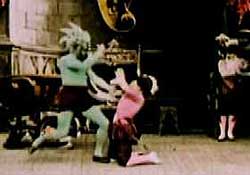 Demons of hell keep putting women in a cauldron, burning them up, in The Infernal Cauldron (Le Chaudron infernal, 1903). At a scant minute & six seconds, way too little happens, but that little is wildly action-oriented. Demons of hell keep putting women in a cauldron, burning them up, in The Infernal Cauldron (Le Chaudron infernal, 1903). At a scant minute & six seconds, way too little happens, but that little is wildly action-oriented.
The set & costumes are quite amazing, with some pyrotechnics thrown in.
It seems very elaborate to have been kept so short, but being in full color caused greater limitations for length, even in the "two minute movie" era, for to make a color film required every frame to be hand-painted.
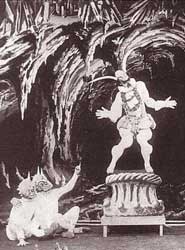 What appears to be another chapter of the same story is The Infernal Cake-Walk (Le Cake-Walk Infernal, 1903), which features Melies as the coolest knock-kneed dancing devil of all time. What appears to be another chapter of the same story is The Infernal Cake-Walk (Le Cake-Walk Infernal, 1903), which features Melies as the coolest knock-kneed dancing devil of all time.
Dancing girls & acrobatic fire-manipulating demons put on a show on a stagy cavern in hell, which looks like quite a fun place.
The centerpiece is the dance called "the cake-walk." This dance originated in the United States among southern black folk who were making fun of the self-important marching-manner of how white folks walked.
The dance occurs in several kinetoscope films including Cake Walk 1903) in which three black men & two black women perform the popular dance of the day, Cake Walk (1903), everyone dressed to the nines.
The same well dressed group of African American dancers perform a slightly sillier version of this dance in Comedy Cake Walk (1903) obviously filmed the same day. It's funnier still when one realizes what caucasians never realized, this dance arose as a parody of the way white folks walk.
White folks not getting the joke began to do the satiric walk as a new dance step. And the dance step spread world-wide. Melies has two of the dancers-in-hell in blackface, acknowledging the dance's origins in black America.
Eventually a knock-kneed goat-legged horned Satan arrives in a puff of smoke & cakewalks on a cake-shaped pedestal, adding the cute trick of letting his legs & arms fly off to dance on their own. The devil's cake-walk is wonderfully antic.
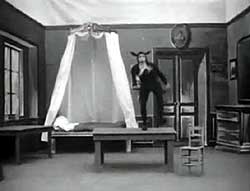 The Black Imp; aka, The Black Devil (Le Diable noir, 1905) is a four-minute film showing an imp (or a chap in black leotards, cat-ears, & tail) leaping about a bedroom. The Black Imp; aka, The Black Devil (Le Diable noir, 1905) is a four-minute film showing an imp (or a chap in black leotards, cat-ears, & tail) leaping about a bedroom.
He jumps from bed to table & whatnot, leaving the film-set before three other characters arrive, two women leading a man. The women, apparently landladies, leave the gentleman alone in the rented room.
Furniture begins stacking & rearranging itself & multiplying & vanishing, to the shock & injury of the horrified lodger.
At length the Imp causing it reappears & the renter chases him about. Amusingly slapstick despite minor injuries, it ends with the poor guy being kicked out by the landladies, & the Imp has the bed to himself.
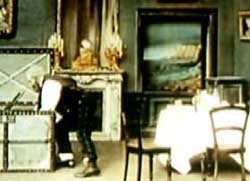 A similar story was filmed by Melies as The Infernal Tenent; aka The Devilish Tenent (Le Locataire Diabolique, 1909), in hand-tinted color. A similar story was filmed by Melies as The Infernal Tenent; aka The Devilish Tenent (Le Locataire Diabolique, 1909), in hand-tinted color.
A traveller rents a room from a rather Turkish looking landlord. The room is unfurnished, but the new tenent removes everything he requires from a small suitcase, including even a fireplace, & arranges the room to his liking, having the ability to simply toss things into their positions.
The large trunk he took from the small suitcase contains everything required for a dinner for six -- table, chairs, food -- including even the guests. At a later time the furniture attacks the landlord, who now realizes he has a diabolical tenant, & flees to tell his wife.
The tenent, having been found out, begins to repack all his posessions including the piano & fireplace in the trunk, puts the trunk in the small suitcase, & departs the residence by the window, leaving behind only a watercloset with a bomb in it.
The demon-haunted room was also used in The Inn Where No Man Rests (L'Auberge du bon repos, 1903)
An inebriated gentleman arrives at the Inn & requires help with his hat, coat, & boots. He's staggering drunk & almost as soon as he's left alone in his room, the portrait on the wall momentarily comes to life.
He's not sure it really happened, but will soon have further evidence of strangeness. It seems the portrait doesn't want him to smoke in the room, & so keeps blowing out the candle with which the drunkard hoped to light his pipe.
The portrait changes to a huge laughing face & the drunk leaps on his bed in surprise, then attacks the coat & hat tree as though worried it too might come alive. His own boots kick him & dance about the room.
Calming himself, as soon as he lies down to sleep, the bed starts hopping about & dumps him on the floor. Imps appear & disappear in the room & the drunk makes a ruckus trying to fight them.
A group of people respond to the noise by flooding into the room, & there's a wild chase in & out of the walls. It's quite a silly comedy all in all.
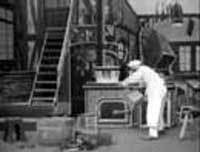 In a busy kitchen we're introduced to The Cook in Trouble (Sorcellerie culinaire, 1903) & his assistants. It's difficult to coordinate all the cookpots at once, & the cook is in a dither. In a busy kitchen we're introduced to The Cook in Trouble (Sorcellerie culinaire, 1903) & his assistants. It's difficult to coordinate all the cookpots at once, & the cook is in a dither.
A beggar enters stage right & the cook has no patience for him & tries to kick him out. So the beggar transforms into a sorcerer & puts a spell on the kitchen.
A salt box suddenly expands to a large size, out of which leaps a tailed monkey-imp. The salt box becomes small again &, unnoticed by the cook or his helpers, the imp empties the salt into a boiling pot of soup.
The box then gets momentarily large so the imp can get back in it & disappear. When the cook tastes the soup, he's horrified & blaming his helpers kicks them all out of the kitchen.
The salt box grows large again & three tailed imps climb out. This time the cook sees what's going on & is caught up in a series of unpleasant experiences with the accursed beings.
The imps climb into the boiling soup pot & evade capture by the cook by sundry methods. Essentially they just keep running about & climbing in the soup pots & exiting from the stove door.
The lack of at least one additional gag, apart from all the running about, makes this one a bit monotonous without a climax, so that it's four minute running time feels rather longer.
For an additional imp tales from Melies, see reviews of Bluebeard (Barbe Bleue, 1901) & An Astronomer's Dream (La Lune a un metre, 1899). There are quite few others, not even counting lost devil-films known from catalog discriptions.
copyright © by Paghat the Ratgirl
|
